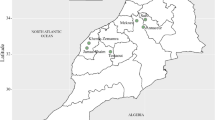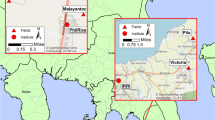Abstract
Wheat blast, caused by Pyricularia oryzae Triticum lineage (PoTl), can infect wheat leaves and heads. More information is needed on the pathogen biology and disease epidemiology of the isolate PoTl for the integrated management of wheat blast in Brazilian wheat fields. This study aimed to characterize the incubation period, latent period, and the temporal progress of wheat blast and to fit nonlinear models, describing the nature of an epidemic of the PoTl isolate 12.1.146 compared with the PoTl isolate Py6038, throughout five successive infection cycles of PoTl on wheat leaves and heads. Wheat blast occurred in all infection cycles. The incubation period and latent period of the PoTl isolate 12.1.146 were significantly shorter than that of the PoTl isolate Py6038. The secondary inocula produced by the PoTl isolate on symptomatic wheat leaves caused blast symptoms when inoculated on wheat heads. The area under the disease progress curve (AUDPC) was calculated based on disease severity. In all infection cycles, the AUDPC of the PoTl isolate 12.1.146 was significantly higher than that of the PoTl isolate Py6038. Between the 1st and 5th infection cycle, a significant reduction was observed in the AUDPC of the PoTl isolates. The nonlinear logistic model describe the disease progress curves (DPCs) of PoTl isolates on wheat leaves and heads best. Our findings indicate that the PoTl isolates did not maintain the same temporal dynamics after five successive infection cycles. These findings may have implications for the integrated management of the wheat blast pathogen in Brazilian fields.





Similar content being viewed by others
Data availability
The epidemiological data that supports the findings of this study are available upon request.
References
Acevedo M., Zurn J., Molero G., et al. (2018). The role of wheat in global food security. In U. S. Nagothu (Eds.), Agricultural Development and Sustainable Intensification (1st ed., pp. 81–110). Routledge. https://doi.org/10.4324/9780203733301
Avila-Adame, C., & Koller, W. (2003). Characterization of spontaneous mutants of Magnaporthe grisea expressing stable resistance to the Qo-inhibiting fungicide azoxystrobin. Current Genetics, 42, 332–338. https://doi.org/10.1007/s00294-002-0356-1
Barragan A., Latorre S., Mock P., et al. (2022). Wild grass isolates of Magnaporthe (Syn. Pyricularia) spp. from Germany can cause blast disease on cereal crops. bioRxiv, 505667. https://doi.org/10.1101/2022.08.29.505667
Bonjean A. P., Angus W. J., Van Ginkel M. (2016). The World Wheat Book: A History of Wheat Breeding. In. (3.)
Callaway, E. (2016). Devastating wheat fungus appears in Asia for first time. Nature, 532, 421–422. https://doi.org/10.1038/532421a
Campbell C. L., Madden L. V. (1990). Introduction to Plant Disease Epidemiology.
Castroagudin, V. L., Ceresini, P. C., De Oliveira, S. C., et al. (2015). Resistance to QoI fungicides is widespread in brazilian populations of the wheat blast pathogen Magnaporthe oryzae. Phytopathology, 105, 284–294. https://doi.org/10.1094/phyto-06-14-0184-r
Castroagudin, V. L., Moreira, S. I., Pereira, D. S., et al. (2016). Pyricularia graminis-tritici, a new Pyricularia species causing wheat blast. Persoonia - Molecular Phylogeny and Evolution of Fungi, 37, 199–216. https://doi.org/10.3767/003158516X692149
Ceresini, P. C., Castroagudin, V. L., Rodrigues, F. A., et al. (2018a). Wheat Blast: Past, Present, and Future. Annual Review of Phytopathology, 56, 427–456. https://doi.org/10.1146/annurev-phyto-080417-050036
Ceresini P. C., Castroagudin V. L., Rodrigues F. A., et al. (2018b). Wheat blast: from its origins in South America to its emergence as a global threat. Molecular Plant Pathology, 10, 1–18. https://doi.org/10.1111%2Fmpp.12747
Colussi, J., Schnitkey, G., & Cabrini, S. (2022). Argentina and Brazil could expand wheat production due to the war in Ukraine. Farmdoc Daily, 12, 48.
Cook, R. J., Hims, M. J., & Vaughan, T. B. (1999). Effects of fungicide spray timing on winter wheat disease control. Plant Pathology, 48, 33–50. https://doi.org/10.1046/j.1365-3059.1999.00319.x
Cruz, C. D., & Valent, B. (2017). Wheat blast disease: Danger on the move. Tropical Plant Pathology, 42, 210–222. https://doi.org/10.1007/s40858-017-0159-z
Cruz, C. D., Kiyuna, J., Bockus, W. W., Todd, T. C., Stack, J. P., & Valent, B. (2015). Magnaporthe oryzae conidia on basal wheat leaves as a potential source of wheat blast inoculum. Plant Pathology, 64, 1491–1498. https://doi.org/10.1111/ppa.12414
D’ Avila L. S., De Filippi M. C. C., Café-Filho A. C. (2022). Fungicide resistance in Pyricularia oryzae populations from southern and northern Brazil and evidence of fitness costs for QoI-resistant isolates. Crop Protection, 153, 105887. https://doi.org/10.1016/j.cropro.2021.105887
Dorigan, A. F., Carvalho, G., Poloni, N. M., Negrisoli, M. M., Maciel, J., & Ceresini, P. C. (2019). Resistance to triazole fungicides in Pyricularia species is associated with invasive plants from wheat fields in Brazil. Acta Scientiarum. Agronomy, 41, 1–10. https://doi.org/10.4025/actasciagron.v41i1.39332
Dorigan, A. F., Moreira, S. I., Ceresini, P. C., et al. (2022). Higher fitness and competitive advantage of Pyricularia oryzae Triticum lineage resistant to QoI fungicides. Pest Manag Science, 78, 5251–5258. https://doi.org/10.1002/ps.7144
Dorigan, A. F., Guimarães, S. S. S., Vicentini, S. N. C., et al. (2023). Pyricularia pennisetigena and Pyricularia urashimae can also cause wheat head blast. European Journal of Plant Pathology, 167, 157–168. https://doi.org/10.1007/s10658-023-02690-3
Duarte H. S. S., Zambolim L., Mizubuti E. S. G., Padua J. G., Ribeiro junior J. I., Carmo E. L., Nogueira junior A. F. (2012). The field resistance of potato cultivars to foliar late blight and its relationship with foliage maturity type and skin type in Brazil. Australasian Plant Pathology, 41, 139-155. https://doi.org/10.1007/s13313-011-0102-6
Faostat. (2020). Food and agriculture organization of the united nations statistics. Retrieved October 4, 2023, from http://www.fao.org/faostat/en/#data/QC
Fernández-Campos, M., Góngora-Canul, C., Das, S., Kabir, M. R., Valent, B., & Cruz, C. D. (2020). Epidemiological criteria to support breeding tactics against the emerging, high-consequence Wheat Blast disease. Plant Disease, 104, 2252–2261. https://doi.org/10.1094/PDIS-12-19-2672-RE
Ferreira E. B., Cavalcanti P. P. (2009). Função em código R para analisar experimentos em DIC simples, em uma só rodada. In: Reunião anual da região brasileira da sociedade internacional de biometria, 54º Simpósio de estatística aplicada a experimentação agronômica SP: UFSCar, 13, 1–5.
Gladieux P., Condon B., Ravel S., Soanes D., Maciel J., Nhani A. J. (2018). Gene flow between divergent cereal- and grass-specific lineages of the rice blast fungus Magnaporthe oryzae. mBio, 9, e01219-e1317. https://doi.org/10.1128/mbio.01219-17.
Gomes, F. P. (1990). Curso de estatística experimental (13th ed.). Nobel.
Gomes, D. P., Rocha, V. S., Rocha, J. R. A., Souza, M. A., & Pereira, O. L. (2019). Progresso temporal da brusone do trigo em função do inóculo primário, da aplicação de fungicida e da resistência dos genótipos. Summa Phytopathologica, 45, 50–58. https://doi.org/10.1590/0100-5405/187354
Gongora-Canul, C., Salgado, J. D., Singh, D., et al. (2020). Temporal dynamics of wheat blast epidemics and disease measurements using multispectral imagery. Phytopathology, 110, 393–405. https://doi.org/10.1094/PHYTO-08-19-0297-R
Goulart, A. C. P., Nasser, L. C. B., & Azevedo, J. D. (2007). Manejo integrado de doenças em trigo irrigado sob pivô central na região do cerrado. Summa Phytopathologica, 33, 358–363. https://doi.org/10.1590/S0100-54052007000400007
Hobbelen, P. H., Paveley, N. D., & Van Den Bosch, F. (2011). Delaying selection for fungicide insensitivity by mixing fungicides at a low and high risk of resistance development: A modeling analysis. Phytopathology, 101, 1224–1233. https://doi.org/10.1094/phyto-10-10-0290
Islam, M. T., Croll, D., Gladieux, P., et al. (2016). Emergence of wheat blast in Bangladesh was caused by a South American lineage of Magnaporthe oryzae. BMC Biology, 14, 84. https://doi.org/10.1186/s12915-016-0309-7
Kranz J. (2003) Comparative epidemiology at the systems levels host, pathogen and disease. In: Comparative epidemiology of plant diseases. Springer, Berlin, Heidelberg. https://doi.org/10.1007/978-3-662-05261-7_4
Mapa. (2021). Agrofit - Sistemas de Agrotóxicos Fitossanitários, Coordenação Geral de Agrotóxicos e Afins. Retrieved October 4, 2023, from http://agrofit.agricultura.gov.br/agrofit_cons/principal_agrofit_cons
Martínez S. I., Sanabria A., Fleitas M. C., Consolo V. F., Perelló A. (2019). Wheat blast: Aggressiveness of isolates of Pyricularia oryzae and effect on grain quality. Journal of King Saud University – Science, 31, 150–7. https://doi.org/10.1016/j.jksus.2018.05.003
Molitor, D., Fruehauf, C., Baus, O., & Berkelmann-Loehnertz, B. (2012). A cumulative degree-day-based model to calculate the duration of the incubation period of Guignardia bidwellii. Plant Disease, 96, 1054–1059. https://doi.org/10.1094/pdis-11-11-1005-re
Mouen Bedimo J. A., Bieysse D., Cilas C., Nottéghem J. L. (2007). Spatio-temporal dynamics of arabica coffee berry disease caused by Colletotrichum kahawae on a plot scale. Plant Disease, 91, 1229-36. https://doi.org/10.1094/PDIS-91-10-1229
Pagani, A. P. S., Dianese, A. C., & Café-Filho, A. C. (2014). Management of wheat blast with synthetic fungicides, partial resistance and silicate and phosphite minerals. Phytoparasitica, 42, 609–617. https://doi.org/10.1007/s12600-014-0401-x
Park, J. H., Choi, G. J., Jang, K. S., Lim, H. K., & Kim, H. T. (2005). Antifungal activity against plant pathogenic fungi of chaetoviridins isolated from Chaetomium globosum. FEMS Microbiology Letters, 252, 309–313. https://doi.org/10.1016/j.femsle.2005.09.013
Rios, J. A., Rios, V. S., Paul, P. A., Souza, M. A., Araujo, L., & Rodrigues, F. A. (2016). Fungicide and cultivar effects on the development and temporal progress of wheat blast under field conditions. Crop Protection, 89, 152–160. https://doi.org/10.1016/j.cropro.2016.07.020
Shaner, G., & Finney, R. E. (1977). The effect of nitrogen fertilization on the expression of slow-mildewing resistance in Knox wheat. Phytopatology, 67, 1051–1056. https://doi.org/10.1094/Phyto-67-1051
Singh, P. K., Singh, A. K., Singh, H. B., & Dhakad, B. K. (2012). Biological control of rice blast disease with Trichoderma harzianum in direct seeded rice under medium low land rainfed conditions. Environment and Ecology, 30, 834–837.
Singh, P. K., Gahtyari, N. C., Roy, C., et al. (2021). Wheat Blast: A disease spreading by intercontinental jumps and its management strategies. Frontiers in Plant Science, 12, 710707. https://doi.org/10.3389/fpls.2021.710707
Tembo, B., Mulenga, R. M., Sichilima, S., et al. (2020). Detection and characterization of fungus (Magnaporthe oryzae pathotype Triticum) causing wheat blast disease on rain-fed grown wheat (Triticum aestivum L.) in Zambia. PLoS One, 15, e0238724. https://doi.org/10.1371/journal.pone.0238724
Van Den Bosch F., Paveley N., Van Den Berg F., Hobbelen P., Oliver R. (2014). Mixtures as a fungicide resistance management tactic. Phytopatology, 1264–73. https://doi.org/10.1094/phyto-04-14-0121-rvw
Vanderplank, J. E. (1963). Plant Diseases: Epidemics and Control. Academic Press.
Zadoks, J. C., Chang, T. T., & Konzak, C. F. (1974). A decimal code for the growth stages of cereals. Weed Research, 14, 415–421. https://doi.org/10.1111/j.1365-3180.1974.tb01084.x
Acknowledgements
Adriano Francis Dorigan was supported by Brazilian Coordination for the Improvement of Higher Education Personnel (CAPES, finance code 001). Silvino Intra Moreira was supported by PDJ/CNPq Postdoc Scholarship (152074/2022-8). Paulo Cezar Ceresini was supported by São Paulo Research Support Foundation, Brazil (Fapesp 2020/07611-9). Eduardo Alves is supported by the National Council for Scientific and Technological Development (CNPq 305482/2017-3, 313825/2018-1, 432445/2018-8, and 306133/2021-0).
Funding
CAPES,CNPQ,FAPESP
Author information
Authors and Affiliations
Corresponding author
Ethics declarations
Research involving human participants and/or animals
This study does not include experiments with either human participants or animals.
Conflict of interest
The authors declare no conflict of interest. The funders had no role in the design of the study; in the collection, analyses, or interpretation of data; in the writing of the manuscript, or in the decision to publish the results.
Supplementary Information
Below is the link to the electronic supplementary material.
Rights and permissions
Springer Nature or its licensor (e.g. a society or other partner) holds exclusive rights to this article under a publishing agreement with the author(s) or other rightsholder(s); author self-archiving of the accepted manuscript version of this article is solely governed by the terms of such publishing agreement and applicable law.
About this article
Cite this article
Dorigan, A.F., Pozza, E.A., Pereira, R.C.M. et al. Temporal dynamics of wheat blast caused by Pyricularia oryzae Triticum lineage throughout the successive wheat cycles. Eur J Plant Pathol (2024). https://doi.org/10.1007/s10658-024-02867-4
Accepted:
Published:
DOI: https://doi.org/10.1007/s10658-024-02867-4




